Related Research Articles

A jet engine is a type of reaction engine discharging a fast-moving jet that generates thrust by jet propulsion. While this broad definition can include rocket, water jet, and hybrid propulsion, the term jet engine typically refers to an internal combustion airbreathing jet engine such as a turbojet, turbofan, ramjet, or pulse jet. In general, jet engines are internal combustion engines.
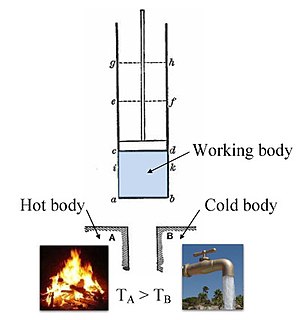
Thermodynamics is a branch of physics that deals with heat, work, and temperature, and their relation to energy, entropy, and the physical properties of matter and radiation. The behavior of these quantities is governed by the four laws of thermodynamics which convey a quantitative description using measurable macroscopic physical quantities, but may be explained in terms of microscopic constituents by statistical mechanics. Thermodynamics applies to a wide variety of topics in science and engineering, especially physical chemistry, biochemistry, chemical engineering and mechanical engineering, but also in other complex fields such as meteorology.

A gas turbine, also called a combustion turbine, is a type of continuous and internal combustion engine. The main elements common to all gas turbine engines are:
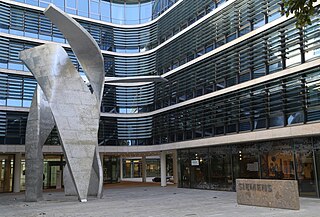
Siemens AG is a German multinational conglomerate corporation and the largest industrial manufacturing company in Europe headquartered in Munich with branch offices abroad.

The turbojet is an airbreathing jet engine, typically used in aircraft. It consists of a gas turbine with a propelling nozzle. The gas turbine has an air inlet which includes inlet guide vanes, a compressor, a combustion chamber, and a turbine. The compressed air from the compressor is heated by burning fuel in the combustion chamber and then allowed to expand through the turbine. The turbine exhaust is then expanded in the propelling nozzle where it is accelerated to high speed to provide thrust. Two engineers, Frank Whittle in the United Kingdom and Hans von Ohain in Germany, developed the concept independently into practical engines during the late 1930s.
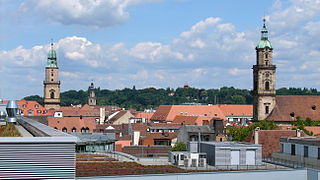
Erlangen is a Middle Franconian city in Bavaria, Germany. It is the seat of the administrative district Erlangen-Höchstadt, and with 113,758 inhabitants, it is the smallest of the eight major cities in Bavaria. The number of inhabitants exceeded the threshold of 100,000 in 1974, making Erlangen a major city according to the statistical definition officially used in Germany.

The bypass ratio (BPR) of a turbofan engine is the ratio between the mass flow rate of the bypass stream to the mass flow rate entering the core. A 10:1 bypass ratio, for example, means that 10 kg of air passes through the bypass duct for every 1 kg of air passing through the core.

A combined cycle power plant is an assembly of heat engines that work in tandem from the same source of heat, converting it into mechanical energy. On land, when used to make electricity the most common type is called a combined cycle gas turbine (CCGT) plant. The same principle is also used for marine propulsion, where it is called a combined gas and steam (COGAS) plant. Combining two or more thermodynamic cycles improves overall efficiency, which reduces fuel costs.
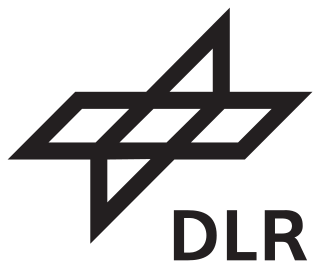
The German Aerospace Center, abbreviated DLR, is the national center for aerospace, energy and transportation research of Germany. Its headquarters are located in Cologne and it has multiple other locations throughout Germany. The DLR is engaged in a wide range of research and development projects in national and international partnerships. In addition to conducting its own research projects, DLR also acts as the German space agency. As such, it is responsible for planning and implementing the German space programme on behalf of the German federal government. As a project management agency, DLR also coordinates and answers the technical and organisational implementation of projects funded by a number of German federal ministries.

The Rankine cycle is an idealized thermodynamic cycle describing the process by which certain heat engines, such as steam turbines or reciprocating steam engines, allow mechanical work to be extracted from a fluid as it moves between a heat source and heat sink. The Rankine cycle is named after William John Macquorn Rankine, a Scottish polymath professor at Glasgow University.
The vortex tube, also known as the Ranque-Hilsch vortex tube, is a mechanical device that separates a compressed gas into hot and cold streams. The gas emerging from the hot end can reach temperatures of 200 °C (392

Friedrich–Alexander University Erlangen–Nürnberg is a public research university in the cities of Erlangen and Nuremberg in Bavaria, Germany. The name Friedrich–Alexander comes from the university's first founder Friedrich, Margrave of Brandenburg-Bayreuth, and its benefactor Alexander, Margrave of Brandenburg-Ansbach.

Aurel Boleslav Stodola was a Slovak engineer, physicist, and inventor. He was a pioneer in the area of technical thermodynamics and its applications and published his book Die Dampfturbine in 1903. In addition to the thermodynamic issues involved in turbine design the book discussed aspects of fluid flow, vibration, stress analysis of plates, shells and rotating discs and stress concentrations at holes and fillets. Stodola was a professor of mechanical engineering at the Swiss Polytechnical Institute in Zurich. He maintained friendly contact with Albert Einstein. In 1892, Stodola founded the Laboratory for Energy Conversion.

This Timeline of heat engine technology describes how heat engines have been known since antiquity but have been made into increasingly useful devices since the 17th century as a better understanding of the processes involved was gained. A heat engine is any system that converts heat to mechanical energy, which can then be used to do mechanical work.They continue to be developed today.

Rudolf Fleischmann was a German experimental nuclear physicist from Erlangen, Bavaria. He worked for Walther Bothe at the Physics Institute of the University of Heidelberg and then at the Institute for Physics of the Kaiser Wilhelm Institute for Medical Research. Through his association with Bothe, he became involved in the German nuclear energy project, also known as the Uranium Club; one of Fleischmann’s areas of interest was isotope separation techniques. In 1941 he was appointed associate professor of experimental physics at the newly established Reichsuniversität Straßburg, in France. Late in 1944, he was arrested under the American Operation Alsos and sent to the United States. After he returned to Germany 1946, he became Director of the State Physical Institute at the University of Hamburg and developed it as a center of nuclear research. In 1953, he took a position at the University of Erlangen and achieved emeritus status in 1969. He was a signatory of the Göttingen Manifesto in 1957.
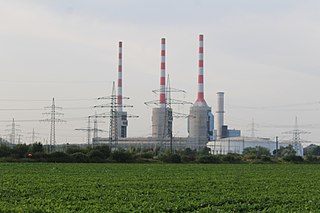
Irsching Power Station near Vohburg at the Danube, Germany, is operated as a so-called Peaking power plant.

Siemens Gamesa Renewable Energy S.A., formerly Gamesa Corporación Tecnológica S.A. and Grupo Auxiliar Metalúrgico S.A., is a Spanish-German wind engineering company based in Zamudio, Biscay, Spain. It manufactures wind turbines and provides onshore and offshore wind services. It is the world's second largest wind turbine manufacturer.
The Siemens Energy Sector was one of the four sectors of German industrial conglomerate Siemens. Founded on January 1, 2008, it generated and delivered power from numerous sources including the extraction, conversion and transport of oil and natural gas in addition to renewable and alternative energy sources. As of October 1, 2014, the sector level has been eliminated, including the Siemens Energy Sector.
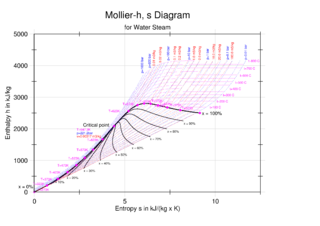
An enthalpy–entropy chart, also known as the H–S chart or Mollier diagram, plots the total heat against entropy, describing the enthalpy of a thermodynamic system. A typical chart covers a pressure range of 0.01–1000 bar, and temperatures up to 800 degrees Celsius. It shows enthalpy in terms of internal energy , pressure and volume using the relationship .
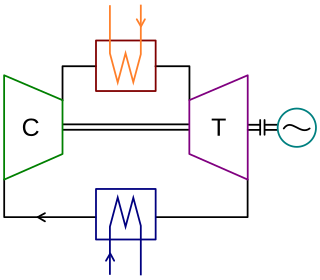
A closed-cycle gas turbine is a turbine that uses a gas for the working fluid as part of a closed thermodynamic system. Heat is supplied from an external source. Such recirculating turbines follow the Brayton cycle.
References
- 1 2 3 "Klaus Ridle (DE)". Non-profit Partnership "Global Energy". Retrieved 2 January 2017.
- ↑ Marsh, Peter (3 February 2005). "GE looks to the next generation". Financial Times . Retrieved 2 January 2017.
- 1 2 Vaughan, Adam (27 October 2010). "Top scientists answer your 'toughest' energy questions". The Guardian . Retrieved 2 January 2017.
- 1 2 3 Eberl, Ulrich; Puma, Joerg (2007). Innovative Minds: A Look Inside Siemens' Idea Machine. John Wiley & Sons. pp. 104–110. ISBN 978-3-89578-606-8 . Retrieved 2 January 2017.
- 1 2 Matzen, Frank J.; Tesch, Ralf (2016). Industrielle Energiestrategie: Praxishandbuch für Entscheider des produzierenden Gewerbes (in German). Springer-Verlag. p. 130. ISBN 978-3-658-07606-1 . Retrieved 3 January 2017.
- ↑ "Staff". University of Erlangen-Nuremberg. Archived from the original on 4 January 2017. Retrieved 2 January 2017.
- ↑ "Moskauer Preis für Energieforschung an Siemens-Manager". Handelsblatt (in German). 28 April 2005. Retrieved 3 January 2017.
- ↑ Savage, Sam (17 June 2005). "Russian, German Win Energy-Related Prize". redOrbit.com. Retrieved 3 January 2017.